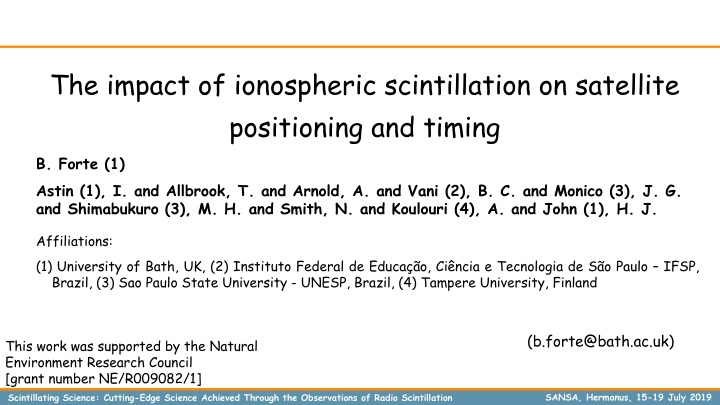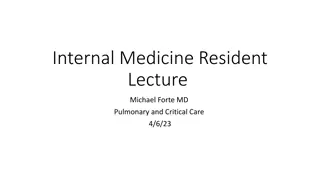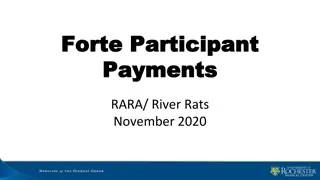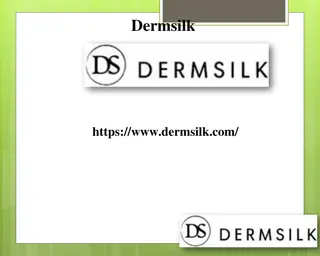
The Impact of Ionospheric Scintillation on Satellite Positioning
Explore the effects of ionospheric scintillation on satellite positioning and timing, leading to potential disruptions in satellite navigation systems. Learn how rapid changes in satellite radio signals can impact accuracy and reliability, with insights from cutting-edge research presented at a science conference in 2019.
Download Presentation

Please find below an Image/Link to download the presentation.
The content on the website is provided AS IS for your information and personal use only. It may not be sold, licensed, or shared on other websites without obtaining consent from the author. If you encounter any issues during the download, it is possible that the publisher has removed the file from their server.
You are allowed to download the files provided on this website for personal or commercial use, subject to the condition that they are used lawfully. All files are the property of their respective owners.
The content on the website is provided AS IS for your information and personal use only. It may not be sold, licensed, or shared on other websites without obtaining consent from the author.
E N D
Presentation Transcript
The impact of ionospheric scintillation on satellite positioning and timing B. Forte (1) Astin (1), I. and Allbrook, T. and Arnold, A. and Vani (2), B. C. and Monico (3), J. G. and Shimabukuro (3), M. H. and Smith, N. and Koulouri (4), A. and John (1), H. J. Affiliations: (1) University of Bath, UK, (2) Instituto Federal de Educa o, Ci ncia e Tecnologia de S o Paulo IFSP, Brazil, (3) Sao Paulo State University - UNESP, Brazil, (4) Tampere University, Finland (b.forte@bath.ac.uk) This work was supported by the Natural Environment Research Council [grant number NE/R009082/1] SANSA, Hermanus, 15-19 July 2019 Scintillating Science: Cutting-Edge Science Achieved Through the Observations of Radio Scintillation
The impact of Ionospheric Scintillation on Satellite Navigation and Positioning Scintillation is rapid changes in satellite radio signals caused when travelling through the Earth s ionosphere. In the presence of scintillation radio receivers (such as those used in satellite navigation applications) can lose the ability to follow such satellite radio signals. Positioning accuracy and reliability are reduced. SANSA, Hermanus, 15-19 July 2019 Scintillating Science: Cutting-Edge Science Achieved Through the Observations of Radio Scintillation
Ionospheric Scintillation Average map of occurrence Areas subject to L-band ionospheric Scintillation SANSA, Hermanus, 15-19 July 2019 Scintillating Science: Cutting-Edge Science Achieved Through the Observations of Radio Scintillation
Ionospheric Scintillation: An example on GPS frequencies (L1 and L2) L2 L1 Cape Verde 29 March 2011 PRN05 SANSA, Hermanus, 15-19 July 2019 Scintillating Science: Cutting-Edge Science Achieved Through the Observations of Radio Scintillation
Ionospheric Scintillation: An example on GPS frequencies (L1 and L2) Cape Verde 29 March 2011 PRN05 SANSA, Hermanus, 15-19 July 2019 Scintillating Science: Cutting-Edge Science Achieved Through the Observations of Radio Scintillation
Average duration of scintillation event (avg_d) S4 > 0.3 SANSA, Hermanus, 15-19 July 2019 Scintillating Science: Cutting-Edge Science Achieved Through the Observations of Radio Scintillation
Maximum duration of a scintillation event (d_max) S4 > 0.3 SANSA, Hermanus, 15-19 July 2019 Scintillating Science: Cutting-Edge Science Achieved Through the Observations of Radio Scintillation
Probability that a random data point belongs to an event of duration above or equal to the duration threshold (p_join=p_all*p_ts_tmin) S4 > 0.3 Duration > 7 min SANSA, Hermanus, 15-19 July 2019 Scintillating Science: Cutting-Edge Science Achieved Through the Observations of Radio Scintillation
EGNOS availability over the chosen area 20 24 LT 16 20 LT Credit: EC FP7 MISW Consortium SANSA, Hermanus, 15-19 July 2019 Scintillating Science: Cutting-Edge Science Achieved Through the Observations of Radio Scintillation
RTK for ground station in Brazil - positioning SANSA, Hermanus, 15-19 July 2019 Scintillating Science: Cutting-Edge Science Achieved Through the Observations of Radio Scintillation
RTK for ground station in Brazil - timing SANSA, Hermanus, 15-19 July 2019 Scintillating Science: Cutting-Edge Science Achieved Through the Observations of Radio Scintillation
Conclusions The results obtained indicate that: 1. The positioning accuracy increases from cm-level (typical of dual- frequency precise positioning) to metre-level at all latitudes under the presence of scintillation (and enhanced TEC fluctuations). 2. The problem is characterised by the severity and duration of scintillation. SANSA, Hermanus, 15-19 July 2019 Scintillating Science: Cutting-Edge Science Achieved Through the Observations of Radio Scintillation
Thank you for your attention! SANSA, Hermanus, 15-19 July 2019 Scintillating Science: Cutting-Edge Science Achieved Through the Observations of Radio Scintillation
SANSA, Hermanus, 15-19 July 2019 Scintillating Science: Cutting-Edge Science Achieved Through the Observations of Radio Scintillation

















